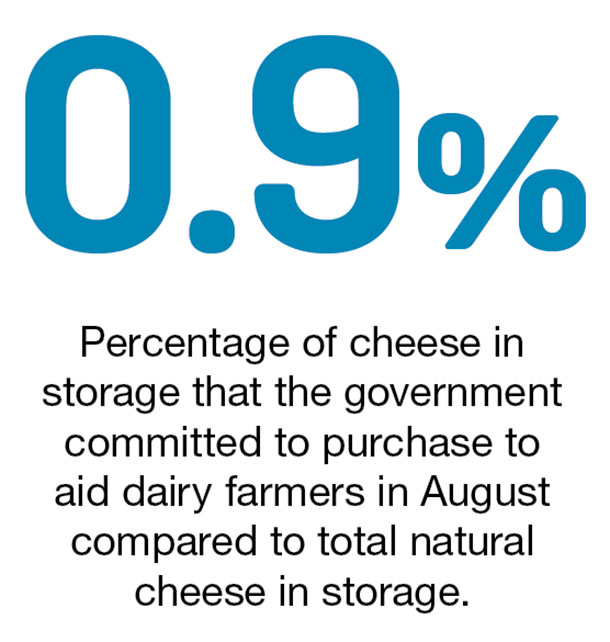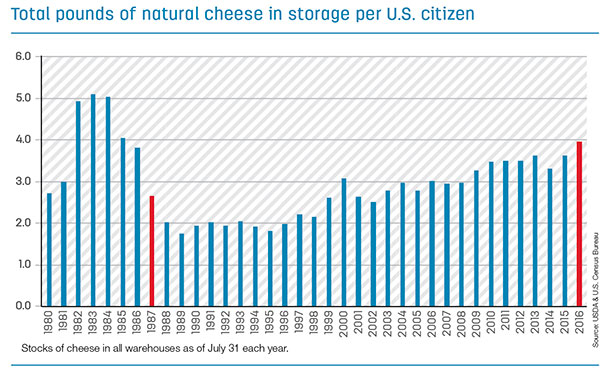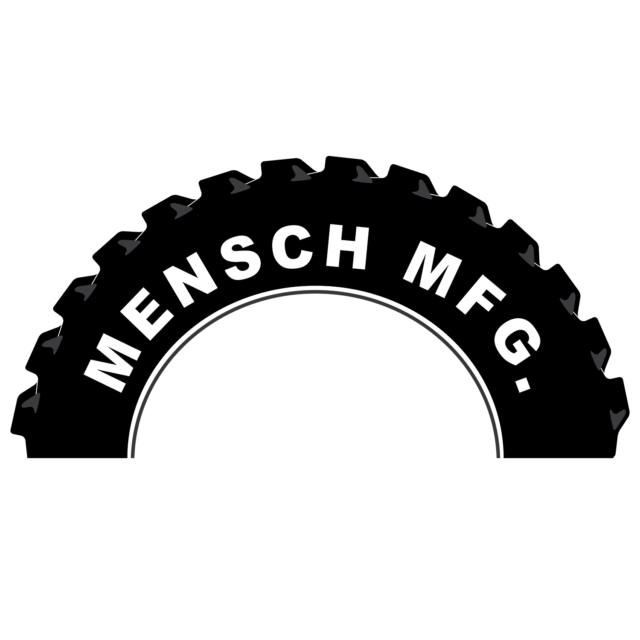The volume of natural cheese in cold storage has attracted a great deal of scrutiny in recent months, garnering attention among industry and political leaders, on social media and late-night talk shows. Cited as a reason for lower milk prices, it also prompted the USDA to announce it would purchase about 11 million pounds of cheese for food banks and feeding programs.
Based on USDA data, “natural” cheese stored in warehouses in the U.S. has reached a 30-year high, matching volumes stored in the mid-1980s.
“Natural” cheese is primarily American- and Italian-type cheeses, produced in the U.S. Volumes of natural cheese cited in USDA cold storage and per-capita consumption reports do not include processed, Swiss, cottage and some other specialty cheeses, nor does it include imported cheeses or cheeses derived from animals other than dairy cows.
While today’s stored cheese volumes are similar to 30 years ago, many things have changed. The U.S. government, which at one time held 60 percent of cheese stocks as part of federal policy to prop up milk prices as part of the Dairy Price Support Program, is no longer in the business of storing cheese in caves.
U.S. per-capita cheese consumption has nearly doubled over the past three decades, and U.S. population has grown by more than 80 million people. In addition, we’re eating more aged cheeses, which require longer times in storage. With annual commercial use of natural cheese nearing 12 billion pounds and based on updated consumption estimates, current stocks represent about five weeks of supply.
In these tables and comments, Progressive Dairyman seeks to put some perspective on current U.S. cheese inventories. The bottom line: It’s not as bad as it looks.

“Cheese stocks are higher than usual, but not out of line with market requirements. I look at days (of usage)-in-store, a metric others don’t seem to use. I use the most recent 12 months of commercial disappearance and compare it to product in storage. Both are in pretty good alignment with usage.
“American stocks are also higher because of product mix. We are consuming more aged/sharp and extra sharp cheese; hence, product is in storage longer. Ditto for other cheese. We’re consuming more hard Italian types – Parmesan for example.”
— Jerry Dryer, Dairy Market Analyst

On May 29, 2016,
Steven Colbert made U.S. cheese stocks part of his monologue on The Late Show with Steven Colbert. He said: “In order to get rid of it, every American would need to eat 3 extra pounds of it this year. I think I say I speak for all Americans when I say, ‘Challenge accepted.’”

#my3pounds
Kipp Hinz helped get the #my3pounds hashtag trending on social media earlier this year. Unfortunately, his 60-cow herd at Hinz Registered Holsteins in Ellsworth, Wisconsin, succumbed to this year’s prolonged milk prices and was sold in August.
In announcing his “failure” on social media, Hinz vowed Hinz Registered Holsteins will “be back.” “God has a plan for me and it will take more than this to knock me out.”

American dairy farmers did not need a bailout at this time. The market was already responding, and feed costs have substantially moderated. From a strategic standpoint, it was unwise for the industry to ask the government for anything right now. We need to be smart in how we interact with the politicians who support our industry.
There may be times when we could benefit from the government helping us out, but this was not one of them. Our industry spent valuable political good will and in this case, got nothing in return.”
— Geoff Vandenheuvel, California dairy producer and a vice president of California’s Milk Producers Council
“We appreciate the prompt action taken by the U.S. Department of Agriculture to purchase $20 million worth of cheese products to donate to food assistance programs.
This cheese purchase will provide some assistance to America’s dairy farmers through increased demand for their milk, while also serving the needs of Americans who patronize food banks and other charitable assistance organizations that will distribute the cheese purchased by USDA.”
— Jim Mulhern, President and CEO of National Milk Producers Federation

“We understand that the nation’s dairy producers are experiencing challenges due to market conditions and that food banks continue to see strong demand for assistance.
This commodity purchase is part of a robust, comprehensive safety net that will help reduce a cheese surplus that is at a 30-year high while, at the same time, moving a high-protein food to the tables of those most in need.”
— USDA Secretary Tom Vilsack Source: USDA & U.S. Census Bureau ![]()

-
Dave Natzke
- Editor
- Progressive Dairyman
- Email Dave Natzke






